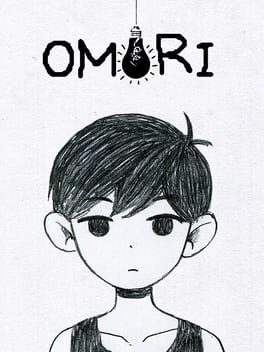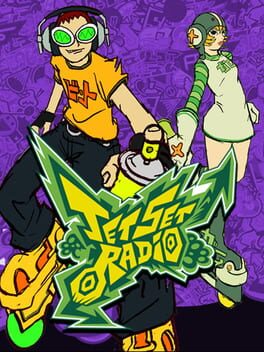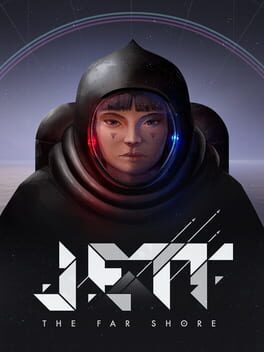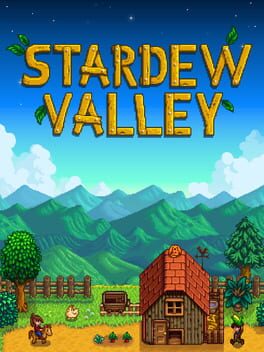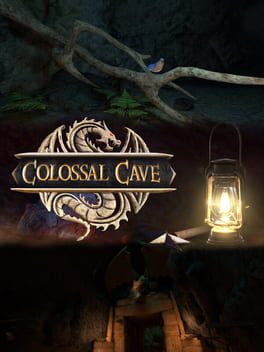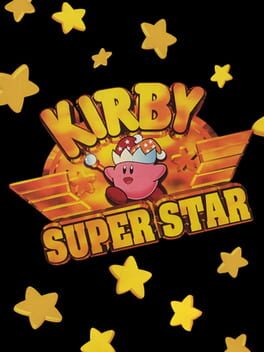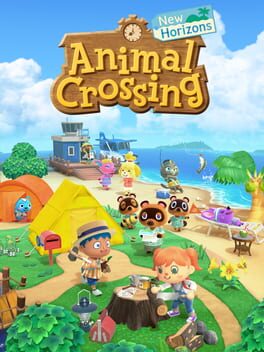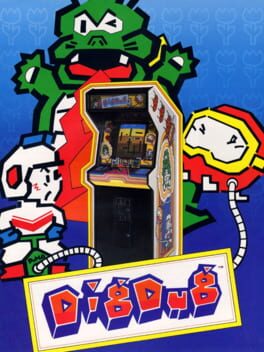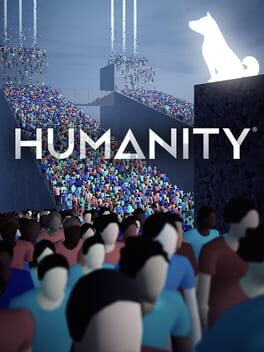222 Reviews liked by Ira
Resident Evil 4
2005
The ultimate game about shooting, a genre often overwhelmed by getting shot. You shoot to kill, shoot to stun, shoot to stop projectiles, shoot to blow explosives, shoot to deactivate traps, you even shoot to be able to not shoot for a bit. You are a microdose sniper, not just because of the need to find the spot, stand still, aim and take the shot, compensating constantly for pulse and breath, but also keeping the laser spot, no matter if the weapon is a shotgun, with one of the comical exceptions being the sniper rifle itself.
Arguably, the main character should be the Merchant, a literal manifestation of gun Doraemon, yet again, this is not a game about weapons. You control Leon because, apart from being hot, he is the shooter.
Arguably, the main character should be the Merchant, a literal manifestation of gun Doraemon, yet again, this is not a game about weapons. You control Leon because, apart from being hot, he is the shooter.
Omori
2020
Jet Set Radio
2012
On the surface, Jet Set Radio may seem like an explicit expression of the urban teenage outrage from something like Tony Hawk games, you do graffiti around town, the police and even the army pursue you, you help an underground illegal radio, everyone is dancing all the time, the visual style is a colorful explosive display of liveliness. On the inside, this is nothing more than the envelope of an identity crisis lie.
What this really is, compared to Tony Hawk, is a simplified version where about two action buttons carry all the movement. The complex techniques of the older game are now automated, which may sound like an improvement in the flow of movement, yet ends up backfiring, as this automation also means that it is much harder to predict what the character is even going to do. In consequence, penalties are also relieved, falling down, even after impossible falls, is a rare sight, grinding rails no longer requires keeping any balance at all. These watered down decisions exist also because of a more careless attention to detail on movement, where something essential as jumps often becomes unexpected leaps of faith. This lack of attention is to be expected.
Tony Hawk games totally committed to translating skating into videogame through an exaggerated arcade abstraction. Where impossible jumps were possible, still an essence was maintained regardless of the surrealism. You had two minutes, a song, and a place where to find your own style to be turned into your combo tricks playground. Jet Set Radio arcade capacities are but a mere curiosity. Perhaps in recognition of not being able to find a game where moving around was satisfactory enough, perhaps in disbelief of the power of arcade, Jet Set Radio is nothing but a game of following steps and getting interrupted.
No longer is the city there as your canvas, the graffiti spots to paint here are clearly marked with red arrows. Those missions at least still leave up to you the routes to get to the different marked points whereas the duels, in Tony Hawk an even more concentrated and heavily penalized one minute jam, are now the epitome of identity robbery. To show your value to others, you copy their exact movements.
The two minute arcade do what you want without additives is now an infinitely generous timed mission full of stops. Start the mission and get a cutscene. Trigger the police, reinforcements, whatever, get another cutscene, even in midair. Pause and open up your map to locate your missing objectives. Search for health refills if you get too many hits. Perform an incredible stunt, like grinding a rail without pressing a button, and get a replay highlight. Paint a graffiti, halt your movement completely regardless of acceleration and complete a quick time event standing still for seconds.
Tony Hawk games, if cynically seen, may look like a messy license mashup in an attempt to grab attention wherever it could, but, above everything, contained a clear idea on what the urban movement on top of a skate meant in its own arcade terms. Jet Set Radio has clear ideas on the aesthetic it wants to reach, but at its heart is, at best, just a confused teenager that prefers to watch the style from afar, afraid of taking the wheels and falling down.
What this really is, compared to Tony Hawk, is a simplified version where about two action buttons carry all the movement. The complex techniques of the older game are now automated, which may sound like an improvement in the flow of movement, yet ends up backfiring, as this automation also means that it is much harder to predict what the character is even going to do. In consequence, penalties are also relieved, falling down, even after impossible falls, is a rare sight, grinding rails no longer requires keeping any balance at all. These watered down decisions exist also because of a more careless attention to detail on movement, where something essential as jumps often becomes unexpected leaps of faith. This lack of attention is to be expected.
Tony Hawk games totally committed to translating skating into videogame through an exaggerated arcade abstraction. Where impossible jumps were possible, still an essence was maintained regardless of the surrealism. You had two minutes, a song, and a place where to find your own style to be turned into your combo tricks playground. Jet Set Radio arcade capacities are but a mere curiosity. Perhaps in recognition of not being able to find a game where moving around was satisfactory enough, perhaps in disbelief of the power of arcade, Jet Set Radio is nothing but a game of following steps and getting interrupted.
No longer is the city there as your canvas, the graffiti spots to paint here are clearly marked with red arrows. Those missions at least still leave up to you the routes to get to the different marked points whereas the duels, in Tony Hawk an even more concentrated and heavily penalized one minute jam, are now the epitome of identity robbery. To show your value to others, you copy their exact movements.
The two minute arcade do what you want without additives is now an infinitely generous timed mission full of stops. Start the mission and get a cutscene. Trigger the police, reinforcements, whatever, get another cutscene, even in midair. Pause and open up your map to locate your missing objectives. Search for health refills if you get too many hits. Perform an incredible stunt, like grinding a rail without pressing a button, and get a replay highlight. Paint a graffiti, halt your movement completely regardless of acceleration and complete a quick time event standing still for seconds.
Tony Hawk games, if cynically seen, may look like a messy license mashup in an attempt to grab attention wherever it could, but, above everything, contained a clear idea on what the urban movement on top of a skate meant in its own arcade terms. Jet Set Radio has clear ideas on the aesthetic it wants to reach, but at its heart is, at best, just a confused teenager that prefers to watch the style from afar, afraid of taking the wheels and falling down.
Jett: The Far Shore
2021
JETT: The Far Shore is afraid of having confidence in its vision. This was a voice playing in the back of my head when I started playing and finished the intro and the first chapter. I hoped it would grow quieter, and that the experience would over time, begin to trust you as part of its world. I rationalized at first that the continuous co-pilot chatter was to inspire and drive home that sense of communion. You are after all, not alone, and one of several pilots all working together to make sure that these new, earnest steps actually make it to a new world intact. In some ways that's still true, visions and pictures, all of the 'acts' you will take serve the colony and make true on the directives of your group religion.
However, the most damning part of JETT is that it cannot and will not trust you. Picture if you will, this example: in one instance, you need to protect a fellow crewmember's ship from enemies that are about to come across. You need to intercept them and then disable or draw them away. The game will pause, for every, single, enemy that shows up. The game will then pause, and show you a way to stop them, and then another way. After about a minute each. It'll even do this when you're already acting, after you've already disabled them, coming in complete violation of what's happening on screen. This isn't in an early chapter mind, this is the penultimate one, very far and near the end of the journey. They've already taught you to disable these enemies before, in the same ways they even present to you now. They've already step-by-step detailed how to intercept chapters before. In the end, they must be damn sure that you know exactly what you should be doing.
I felt a deep pain in my heart when not long after this I came to one of them on the mother ship and they told me how brave and self-directed I was, how strong a scout and example I made for the colony. All while in that same breath I could just remember the people who might as well have been talking to me as a dog following orders. I felt a dissociative pushback when at a couple moments, there would be quiet time. A time to just explore, and even there I could not get minutes of solace, because the objective would update or the co-pilot would chatter about what I'm already seeing.
To me that's extremely disappointing, almost hurtful especially when the story really stresses at points that there'll be a time to Adapt that will bring your group to its knees, and you must help them. Was I really? Was I really a part of this journey? Was I my own person at any point? I do not feel like a walker on these shores, I am no explorer discovering the planet, I am no voice within the cacophony of radio, I am no identity in these cosmic waters. I am merely the glorified observer, brought out of my role when the priest has deemed me minutes to act on something more, wishing that we were truly something more.
However, the most damning part of JETT is that it cannot and will not trust you. Picture if you will, this example: in one instance, you need to protect a fellow crewmember's ship from enemies that are about to come across. You need to intercept them and then disable or draw them away. The game will pause, for every, single, enemy that shows up. The game will then pause, and show you a way to stop them, and then another way. After about a minute each. It'll even do this when you're already acting, after you've already disabled them, coming in complete violation of what's happening on screen. This isn't in an early chapter mind, this is the penultimate one, very far and near the end of the journey. They've already taught you to disable these enemies before, in the same ways they even present to you now. They've already step-by-step detailed how to intercept chapters before. In the end, they must be damn sure that you know exactly what you should be doing.
I felt a deep pain in my heart when not long after this I came to one of them on the mother ship and they told me how brave and self-directed I was, how strong a scout and example I made for the colony. All while in that same breath I could just remember the people who might as well have been talking to me as a dog following orders. I felt a dissociative pushback when at a couple moments, there would be quiet time. A time to just explore, and even there I could not get minutes of solace, because the objective would update or the co-pilot would chatter about what I'm already seeing.
To me that's extremely disappointing, almost hurtful especially when the story really stresses at points that there'll be a time to Adapt that will bring your group to its knees, and you must help them. Was I really? Was I really a part of this journey? Was I my own person at any point? I do not feel like a walker on these shores, I am no explorer discovering the planet, I am no voice within the cacophony of radio, I am no identity in these cosmic waters. I am merely the glorified observer, brought out of my role when the priest has deemed me minutes to act on something more, wishing that we were truly something more.
Stardew Valley
2016
I won't lie – I spent 100 hours on my single playthrough. Every addicting hook from the Harvest Moon series is nailed in this tribute, bringing out your inner capitalist and matchmaker. But to what end? Like its predecessors, Stardew Valley has nothing to say about your activity. It simply wants you to do more of it. I looked upon my barns, fields, and sheds, and thought, “Is this it?” That's right – I had a mid-life crisis in Stardew Valley, and it had no answers for my emptiness.
Colossal Cave
2023
While a direct translation to 3D of a game that just with the title “Colossal Cave Adventure” is an evident good idea, the too literally attached attempt to homage the original weighs down the experience.
As expected, the huge cave is wonderfully modeled, just as the hazy original text suggested, to maintain an overwhelming first impression. In the lack of confidence of pure exploration, also known as pure adventure, the original ended up being turned into a long term strategy game where to plan out your movements according to illogical trial and error procedures discovered in previous playthroughs. An abandonment of genuine geographical/magical discovery for a more bland, gamey repetition exercise.
This remake not only maintains the exact same problem, but adds a couple of its own when the senseless non-geographical elements need to be translated. Moments that still felt genuine in the original like the pirate or the dwarves appearing out of nowhere didn't need an explanation because of the turn based text narration abstraction itself. This, now in a literal 3D representation, means that these same characters appear and disappear out of magical smoke as you get paralyzed waiting for them to mess with you. This also applies to some of the puzzles. It happens in the puzzles that retained some sense, like being unable to carry the gold nugget to an upper floor, here being contradicted by the floors being separated explicitly with samey stairs in which some arbitrarily allow you to carry the gold and some others not. And it happens in the puzzles that didn’t make that much sense, the spatially impossible labyrinths may get a pass because of the inevitable omissions of text narration nature, but here it is just an unacceptable same looking room where the obvious loading screens magic trick just comes off as cheap.
Since there are obvious downsides to the literal transformation of the blandest parts in the original game, it would be nice to embrace the spatial twists and its own 3D geographical nature in all its glory without additives. What a coincidence that the “adventure” part was dropped from the title.
As expected, the huge cave is wonderfully modeled, just as the hazy original text suggested, to maintain an overwhelming first impression. In the lack of confidence of pure exploration, also known as pure adventure, the original ended up being turned into a long term strategy game where to plan out your movements according to illogical trial and error procedures discovered in previous playthroughs. An abandonment of genuine geographical/magical discovery for a more bland, gamey repetition exercise.
This remake not only maintains the exact same problem, but adds a couple of its own when the senseless non-geographical elements need to be translated. Moments that still felt genuine in the original like the pirate or the dwarves appearing out of nowhere didn't need an explanation because of the turn based text narration abstraction itself. This, now in a literal 3D representation, means that these same characters appear and disappear out of magical smoke as you get paralyzed waiting for them to mess with you. This also applies to some of the puzzles. It happens in the puzzles that retained some sense, like being unable to carry the gold nugget to an upper floor, here being contradicted by the floors being separated explicitly with samey stairs in which some arbitrarily allow you to carry the gold and some others not. And it happens in the puzzles that didn’t make that much sense, the spatially impossible labyrinths may get a pass because of the inevitable omissions of text narration nature, but here it is just an unacceptable same looking room where the obvious loading screens magic trick just comes off as cheap.
Since there are obvious downsides to the literal transformation of the blandest parts in the original game, it would be nice to embrace the spatial twists and its own 3D geographical nature in all its glory without additives. What a coincidence that the “adventure” part was dropped from the title.
Kirby Super Star
1996
Never before has Kirby felt better or looked better.
The abilities go from 1 move to having their own entire move set, which is insane.
I can now summon my own little buddies, eat a max tomato, kiss them on the lips and heal them.
I like the progression system of Adventure more.
I can't be assed to care as much about 5 disjointed adventures. Also, I hate the cave game. I won't talk about it ever again.
The abilities go from 1 move to having their own entire move set, which is insane.
I can now summon my own little buddies, eat a max tomato, kiss them on the lips and heal them.
I like the progression system of Adventure more.
I can't be assed to care as much about 5 disjointed adventures. Also, I hate the cave game. I won't talk about it ever again.
Review
I gave it a real shot, for 8 hours!
You can read my notes and thoughts here : https://twitter.com/han_tani2/status/1735187901296836666
Or read an essay in which I discuss TotK https://melodicambient.substack.com/p/why-ocarina-of-time-cant-be-recreated
The short version is: the game has its nice charming moments, I actually like the idea of janky physics dungeons and riding around on stuff. NPC designs are nice and some of the side quests looked interesting. But I hattteee the crafting stuff, it kind of ends up padding almost everything in the game out. There's also so much distraction, it feels like YouTube recommendations or TikTok...
Shitpost review
Zelda but if Miyamoto wasn't inspired by wandering the countryside as a kid but opening up Genshin enough times to get the 30 day login bonus
I gave it a real shot, for 8 hours!
You can read my notes and thoughts here : https://twitter.com/han_tani2/status/1735187901296836666
Or read an essay in which I discuss TotK https://melodicambient.substack.com/p/why-ocarina-of-time-cant-be-recreated
The short version is: the game has its nice charming moments, I actually like the idea of janky physics dungeons and riding around on stuff. NPC designs are nice and some of the side quests looked interesting. But I hattteee the crafting stuff, it kind of ends up padding almost everything in the game out. There's also so much distraction, it feels like YouTube recommendations or TikTok...
Shitpost review
Zelda but if Miyamoto wasn't inspired by wandering the countryside as a kid but opening up Genshin enough times to get the 30 day login bonus
Un ejemplo perfecto de lobo con piel de cordero.
Bajo el disfraz de la monería y la amabilidad, unas dinámicas devastadoramente consumistas. Nada se hace como fin en sí mismo, por el gusto que pueda dar, sino para conseguir más monedas (y en este juego no sólo hay bayas, como en los demás, hay hasta 3 clases de dinero) o más espacio en el trastero. Es decir, el fin es la pura acumulación de riqueza y bienes. Pescar, bucear, hablar con tus vecinos, se vuelven actos mezquinos y egoístas bajo esta perspectiva.
Respecto a la amplia capacidad de moldear tu isla a tu gusto, el juego se revela igual de podrido ideológicamente. No hay respeto por el mundo, por la gente con la que lo cohabitas. Absolutamente todo gira en torno a ti y a lo que puedas conseguir tú. Mejores gráficos, una isla más grande, más eventos, pero todo al gusto del consumidor. Y por tanto inerte, sin vida. 𝑨 𝒍𝒊𝒇𝒆𝒍𝒆𝒔𝒔 𝒍𝒊𝒇𝒆-𝒔𝒊𝒎.
"Pero es un juego para niños, no hay que darle tantas vueltas, hombre."
1. No, no lo es, todos los millenials que conozco juegan a esto.
2. Incluso si así lo fuera, con más razón se critica la entrada más abyecta de la franquicia.
Bajo el disfraz de la monería y la amabilidad, unas dinámicas devastadoramente consumistas. Nada se hace como fin en sí mismo, por el gusto que pueda dar, sino para conseguir más monedas (y en este juego no sólo hay bayas, como en los demás, hay hasta 3 clases de dinero) o más espacio en el trastero. Es decir, el fin es la pura acumulación de riqueza y bienes. Pescar, bucear, hablar con tus vecinos, se vuelven actos mezquinos y egoístas bajo esta perspectiva.
Respecto a la amplia capacidad de moldear tu isla a tu gusto, el juego se revela igual de podrido ideológicamente. No hay respeto por el mundo, por la gente con la que lo cohabitas. Absolutamente todo gira en torno a ti y a lo que puedas conseguir tú. Mejores gráficos, una isla más grande, más eventos, pero todo al gusto del consumidor. Y por tanto inerte, sin vida. 𝑨 𝒍𝒊𝒇𝒆𝒍𝒆𝒔𝒔 𝒍𝒊𝒇𝒆-𝒔𝒊𝒎.
"Pero es un juego para niños, no hay que darle tantas vueltas, hombre."
1. No, no lo es, todos los millenials que conozco juegan a esto.
2. Incluso si así lo fuera, con más razón se critica la entrada más abyecta de la franquicia.
Videoverse
2023
A conglomeration of impossible nostalgias: Nintendo DS tactile device, messenger chats, barely functional webcams, two colored pixelated games and UI, fan art forums, 2000s trends posters… Videoverse basically takes whatever is convenient from each place while giving a kind of immortal internet nostalgia, where seeing the face of someone from another country in a laggy exchange is a kind of magical event, both in its unimaginable existence just a few decades ago and in its low fidelity technological mystique. This blurry yet distinct mass also carries a meaning of both the degree of precision at recalling our memories and how videogames work better with few charismatic gestures, scarce and giant pixels changing the face expression to tell absolutely everything.
In this virtual reality, completely opening yourself is both the only possible and most risky place to do so. Everything is volatile, logging off is erasing your existence and the servers shutting down is the end of the world on top of your desk. As messy as it may be, Videoverse is undeniably a home. The more times you log in, the more those nicknames become your neighbors. For a teenager still figuring out the world, it is as easy to assimilate as reality.
In this place where it is technically impossible to tell apart true from false, love is still the biggest unexplainable truth.
https://www.youtube.com/watch?v=wcKsxHURj24
In this virtual reality, completely opening yourself is both the only possible and most risky place to do so. Everything is volatile, logging off is erasing your existence and the servers shutting down is the end of the world on top of your desk. As messy as it may be, Videoverse is undeniably a home. The more times you log in, the more those nicknames become your neighbors. For a teenager still figuring out the world, it is as easy to assimilate as reality.
In this place where it is technically impossible to tell apart true from false, love is still the biggest unexplainable truth.
https://www.youtube.com/watch?v=wcKsxHURj24
Promesa
2020
People won't recognize themselves in this places, but isn't that kinda the point?
The place everyone can recognize is the one created by the mind. Peeling back the memories of a house is a daunting task, even if it's not our own.
The physical place will be the only thing outliving us. Us will be long gone.
The place everyone can recognize is the one created by the mind. Peeling back the memories of a house is a daunting task, even if it's not our own.
The physical place will be the only thing outliving us. Us will be long gone.
Dig Dug
1982
Dig Dug is my favourite classic arcade game. Something where both its mechanical depth and its immediate charm work spectacularly well in tandem. The experience of learning how to get good at an old arcade game often involves outside learning, reading up on clandestine techniques discovered from decades old Japan-only player guides and deeplearning AI bot routines, but Dig Dug gives you enough on-screen to intuit how to become a better player.
It's comparable to Pac-Man and QIX, but offers a far more compelling set of rules than either of them. A single-screen game where monsters roam and chase you, but you can move in any direction. You create tunnels as you move, and when an enemy gets in your tunnel, they beeline straight for you. This can be exploited to lead them towards traps, crushing them with rocks, or if you get desperate, you can take them out by getting your pump and inflating them until they burst like a balloon. The lower on the screen you kill an enemy, the higher your score, and if you manage to crush multiple enemies at the same time, that'll increase your score further.
I think a lot of people try Dig Dug, only use the pump, and dismiss it as a bit of a cute novelty, but once you learn that your priority should be crushing enemies, it really starts to come together. That's when the draw towards trying again becomes truly powerful.
When you become really familiar with the game, you'll start to learn the characteristics of Pooka and Fygar AI. You'll be temporarily inflating enemies and running away, to keep them at bay without blowing the points you could get from them. You'll develop strategies you'll lean back on in specific scenarios. I've developed a very specific route through Level 1, in an attempt to reliably maximise my score early on, but I don't even know if it's the best way to approach that layout of tunnels, rocks and enemies. That's what I like so much about Dig Dug. I'm leaning back on what's worked for me, but another player might have completely different solutions. It's why I've largely tried to block-out professional and speedrunning communities. My relationship with the game is the one sacred element in my enjoyment of videogames. I don't want to be told the "right way" to do it. Just leave me alone with Dig Dug. I don't need to get Twin Galaxies in on this shit. I'm not interested in learning someone else's dance routine.
It's that freedom that Dig Dug presents. You can go in any direction at any point. It's Pac-Man, but you're creating the maze yourself. You can get greedy and invite the whole screen of enemies to chase you towards a trap, but you'd better know exactly what you're working with. An unexpected detour could be the death of you.
On my best sessions, I've been setting up false paths to slow down enemies, and seeing them reliably waste their time in empty corridors while I construct my master trap elsewhere. When you know what you can really do with a Dig Dug screen, there's no denying that this game is lightyears ahead of its competition. There's so much freedom, and the threat of failure is always real, present and on-screen. The risk/reward dynamic is so tangible and alluring. Knowing my own tastes, it's a game I'd strongly recommend to classic Metal Gear fans.
One thing I'd like to make clear is that players should be wary of the console ports. If it's not running the arcade version, you probably don't want to waste your time on it. I've been really impressed with the MSX version, replicating the precise AI quirks of the arcade game in a version with more rudimentary presentation, and I'm able to approach scenarios with the same techniques I've learned on the arcade version. The Famicom/NES version tends to get ported a lot, and I'd strongly discourage the purchase of My Arcade systems that emulate it. If you really want to challenge yourself to learn the depth of the game's quirks, I'd encourage you to try the PS4/Xbox One ARCADE GAME SERIES: DIG DUG release and chase the "Dig" achievement, where you have to clear an entire screen of dirt while keeping at least two enemies active on the screen. It's not something you'll be able to do without knowing the game inside out, but again, you'll be able to intuit all of that by playing it.
Dig Dug is a game I'll never stop playing. Something that has really built my respect for Namco and simplistic game design. Everyone likes a Pooka. It's knowing how much you can get from them that really makes Dig Dug great.
It's comparable to Pac-Man and QIX, but offers a far more compelling set of rules than either of them. A single-screen game where monsters roam and chase you, but you can move in any direction. You create tunnels as you move, and when an enemy gets in your tunnel, they beeline straight for you. This can be exploited to lead them towards traps, crushing them with rocks, or if you get desperate, you can take them out by getting your pump and inflating them until they burst like a balloon. The lower on the screen you kill an enemy, the higher your score, and if you manage to crush multiple enemies at the same time, that'll increase your score further.
I think a lot of people try Dig Dug, only use the pump, and dismiss it as a bit of a cute novelty, but once you learn that your priority should be crushing enemies, it really starts to come together. That's when the draw towards trying again becomes truly powerful.
When you become really familiar with the game, you'll start to learn the characteristics of Pooka and Fygar AI. You'll be temporarily inflating enemies and running away, to keep them at bay without blowing the points you could get from them. You'll develop strategies you'll lean back on in specific scenarios. I've developed a very specific route through Level 1, in an attempt to reliably maximise my score early on, but I don't even know if it's the best way to approach that layout of tunnels, rocks and enemies. That's what I like so much about Dig Dug. I'm leaning back on what's worked for me, but another player might have completely different solutions. It's why I've largely tried to block-out professional and speedrunning communities. My relationship with the game is the one sacred element in my enjoyment of videogames. I don't want to be told the "right way" to do it. Just leave me alone with Dig Dug. I don't need to get Twin Galaxies in on this shit. I'm not interested in learning someone else's dance routine.
It's that freedom that Dig Dug presents. You can go in any direction at any point. It's Pac-Man, but you're creating the maze yourself. You can get greedy and invite the whole screen of enemies to chase you towards a trap, but you'd better know exactly what you're working with. An unexpected detour could be the death of you.
On my best sessions, I've been setting up false paths to slow down enemies, and seeing them reliably waste their time in empty corridors while I construct my master trap elsewhere. When you know what you can really do with a Dig Dug screen, there's no denying that this game is lightyears ahead of its competition. There's so much freedom, and the threat of failure is always real, present and on-screen. The risk/reward dynamic is so tangible and alluring. Knowing my own tastes, it's a game I'd strongly recommend to classic Metal Gear fans.
One thing I'd like to make clear is that players should be wary of the console ports. If it's not running the arcade version, you probably don't want to waste your time on it. I've been really impressed with the MSX version, replicating the precise AI quirks of the arcade game in a version with more rudimentary presentation, and I'm able to approach scenarios with the same techniques I've learned on the arcade version. The Famicom/NES version tends to get ported a lot, and I'd strongly discourage the purchase of My Arcade systems that emulate it. If you really want to challenge yourself to learn the depth of the game's quirks, I'd encourage you to try the PS4/Xbox One ARCADE GAME SERIES: DIG DUG release and chase the "Dig" achievement, where you have to clear an entire screen of dirt while keeping at least two enemies active on the screen. It's not something you'll be able to do without knowing the game inside out, but again, you'll be able to intuit all of that by playing it.
Dig Dug is a game I'll never stop playing. Something that has really built my respect for Namco and simplistic game design. Everyone likes a Pooka. It's knowing how much you can get from them that really makes Dig Dug great.
NieR: Automata
2017
Dismembering bodies, dismembering reality.
What i liked most from the first Nier was Taro's ability to play with what constitutes a being, and how bodies are transformed several times taking different forms. He has the ability to twist his stories and his characters, so that the confusion that arises from all the endings and new perspectives is not only to show the futility of conflict, but that the real conflict is upon our own bodies.
Nier Automata takes it even further. The only bodies that remain in the world are machine lifeforms. They can be replaced with spareparts, the androids are different from alien machines, but machines can fuse and give birth to androids, and androids are formed with machines' nucleus, and then everyone fights each other, while searching for a human soul.
They build community, they are greedy, they need connection, they need love, they need solitude. They feel. And their bodies keep twisting and turning and breaking and reconstructing and deconstructing and nothing remains the same anymore, because our bodies are in constant death and rebirth as time passes, and we meet new people and they change us and we change them in return. Such is the pain and grace of living.
What i liked most from the first Nier was Taro's ability to play with what constitutes a being, and how bodies are transformed several times taking different forms. He has the ability to twist his stories and his characters, so that the confusion that arises from all the endings and new perspectives is not only to show the futility of conflict, but that the real conflict is upon our own bodies.
Nier Automata takes it even further. The only bodies that remain in the world are machine lifeforms. They can be replaced with spareparts, the androids are different from alien machines, but machines can fuse and give birth to androids, and androids are formed with machines' nucleus, and then everyone fights each other, while searching for a human soul.
They build community, they are greedy, they need connection, they need love, they need solitude. They feel. And their bodies keep twisting and turning and breaking and reconstructing and deconstructing and nothing remains the same anymore, because our bodies are in constant death and rebirth as time passes, and we meet new people and they change us and we change them in return. Such is the pain and grace of living.
Humanity
2023
For the first half, Humanity is an alright puzzle game. It falls into many irregular puzzle conventions of my personal dislike, focusing on introducing a large number of mechanics instead of being smart with the available tools, yet it still reaches some very high points of wit, even with the ideas that made me raise my eyebrow at first glance.
At the half of the game, the main surprise is the genre shift. The principal difference between the stealth, strategy, action, platformer or whatever else new facets of this second half is that, contrary to the first one, the quality ranges from bad to very bad. The principles established to make a good puzzle game do not cover enough range to go further from a surface recognition of the other genres. Even the genre shift idea itself seems less smart than the game thinks when noticing that the radical change comes from a single power up introduction. The first step to turn a Mario game into a shooter is giving him a gun.
This shift could be taken at least from its symbolic significance (hard thing to do considering the detachment that the narrative provokes by seeming more concerned with pretending to care about the big questions rather than caring about really anything), if it wasn't because of the occasional puzzle comebacks and, honestly, no idea how rejecting the puzzle nature or branching from it should be a positive read on humanity’s capacity instead of a signal of its incapacity.
To the puzzle that was the lack of ideas halfway through the journey, the proposed solution was to break all rules, forgetting why they existed, mistaking becoming a fragile shifting shadow of greater ones with an alternative way to find its own identity. The solution was to stop right there.
At the half of the game, the main surprise is the genre shift. The principal difference between the stealth, strategy, action, platformer or whatever else new facets of this second half is that, contrary to the first one, the quality ranges from bad to very bad. The principles established to make a good puzzle game do not cover enough range to go further from a surface recognition of the other genres. Even the genre shift idea itself seems less smart than the game thinks when noticing that the radical change comes from a single power up introduction. The first step to turn a Mario game into a shooter is giving him a gun.
This shift could be taken at least from its symbolic significance (hard thing to do considering the detachment that the narrative provokes by seeming more concerned with pretending to care about the big questions rather than caring about really anything), if it wasn't because of the occasional puzzle comebacks and, honestly, no idea how rejecting the puzzle nature or branching from it should be a positive read on humanity’s capacity instead of a signal of its incapacity.
To the puzzle that was the lack of ideas halfway through the journey, the proposed solution was to break all rules, forgetting why they existed, mistaking becoming a fragile shifting shadow of greater ones with an alternative way to find its own identity. The solution was to stop right there.
Pikmin
2001
The Libra and Sagittarius are souvenirs given to Olimar by his two children and are considered mandatory ship parts, yet they seem to be nothing more than two identical jewels on the sides of his ship. By not collecting these parts, you could essentially create a playthrough where Olimar's failure to leave the planet would not be from a lack of a functioning ship, but instead from not being able to live with leaving behind the gifts his children gave him. There's a lot I could say about this game, but this is the thought that sticks out to me the most.

